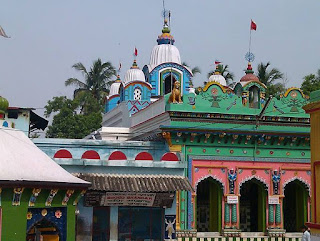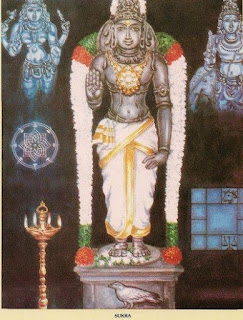The Gopinath Temple of Remuna
Nestling on the eastern coast of the Bay of Bengal lies the small, quiet town of Balasore. Ten kilometers away lies the sleepy semi-town of Remuna. This place shelters five places of consecration, viz, Shri Khirochora Gopinath Mandir, Shri Ramchandi Mandir, Shri Madhabendra Puri Matha, the Saptasara River, and Gadagadeswara Mahadeva Mandir. Out of these five emblems of religious fervor, Shri Gopinath Mandir is the one that has gained global popularity because of the story that underlines its existence in the tiny town of Remuna.
The legend behind the origin of Lord Gopinath lays down that, in the Tretya Yug, Shri Ramachandra had been in exile along with his wife Sita and brother Lakshman. When Shri Rama was in Dandakaranya one day watching a cowman tending to his cows, he smiled a bit. Sita, on seeing her husband smile, inquisitively asked the reason behind that smile. Rama predicted that in the Dwapar Yug, he will take birth as Lord Krishna and would in the same way tend to the cows at the banks of river Yamuna.
On listening to this prediction, Sita insisted Rama show her an image of Lord Krishna. Lord Rama on the request of goddess Sita, engraved an image of Shri Krishna on a black granite stone lying there. As soon as goddess Sita laid her hands on the image, it came to life. With the passage of time, this engraved stone was found by King Langula Narasimha Deva who installed it in Remuna. From that day onwards the image has been worshipped as Lord Gopinath.
Another legend lays down the story that Remuna got its name from the fact that it was ramanya, or a very beautiful landscape. It was such a beautiful place that Lord Gopinath instructed King Langula Narasimha Deva in a dream that he wanted to be worshipped in that place. The King obeyed the instructions and constructed a temple in the very place, naming it Shri Gopinath Mandir. In the course of time, Shri Chaitanya's guru Ishwarpuri, and Ishwarpuri's guru, Shri Madhavendrapuri came to Remuna and ultimately the Deity that was established in the temple was christened Sri Gopinath. Thus this place gained immense popularity in the whole of India.
The full name of Gopinath Mandir is Khirachora Gopinath temple. Khirachora means one who stole the milk bhog (ambrosia). Every aspect of the temple has a story attached to it, including the story behind the christening of the temple. It is believed that Shri Madhavendrapuri, one of the devout devotees of Lord Gopinath had once visited this temple. After completing his prayers, he wanted to have the khira bhog (milk ambrosia), but as was his want, he never begged for food. With a heavy heart, he went to the nearby Ramachandi temple and started singing hymns in praise of Lord Gopinath.
It is a daily ritual in the temple that every day, twelve pots of khira bhog are offered to the Deity. On that very day, when those twelve pots of bhog were offered to the Lord, the priests found to their utter surprise that one pot of the milk bhog was missing. The priests desperately searched for the missing pot, as it was regarded a bad omen if God's offerings are stolen. To their disappointment, they found nothing. That very night, the Lord appeared in a dream of the chief priest of the temple and laid bare the whole secret behind the mystery of the stolen milk pot. He said that it was none other than he who had stolen the milk pot and hidden it inside the cloth that his idol is wearing. He further instructed the priest to immediately go and offer the pot of bhog to his favourite devotee, Shri Madhavendrapuri.
The priest at once woke up and went to the main chamber where the Deities were and to his surprise found a pot of bhog. He took it and immediately offered it to Shri Madhavendrapuri, who was quietly sleeping under a tree in front of the Ramachandi temple. This incident rapidly spread far and wide, thus bringing a huge number of devotees, and worldwide popularity to the place.
It is a crime to steal, but the Lord himself committed this crime for the love of His disciple. It is a rare instance of God serving His devotee. This temple exemplifies God's unflinching and true love for His ardent believer. A visit to this holy place is, therefore, a must for every believer of Shri Gopinath.
Devidutta Das, author of this Orissa Review article, adapted here above, is an Asst. Prof. of English at the Silicon Institute of Technology, Bhubaneswar.
On listening to this prediction, Sita insisted Rama show her an image of Lord Krishna. Lord Rama on the request of goddess Sita, engraved an image of Shri Krishna on a black granite stone lying there. As soon as goddess Sita laid her hands on the image, it came to life. With the passage of time, this engraved stone was found by King Langula Narasimha Deva who installed it in Remuna. From that day onwards the image has been worshipped as Lord Gopinath.
Another legend lays down the story that Remuna got its name from the fact that it was ramanya, or a very beautiful landscape. It was such a beautiful place that Lord Gopinath instructed King Langula Narasimha Deva in a dream that he wanted to be worshipped in that place. The King obeyed the instructions and constructed a temple in the very place, naming it Shri Gopinath Mandir. In the course of time, Shri Chaitanya's guru Ishwarpuri, and Ishwarpuri's guru, Shri Madhavendrapuri came to Remuna and ultimately the Deity that was established in the temple was christened Sri Gopinath. Thus this place gained immense popularity in the whole of India.
The full name of Gopinath Mandir is Khirachora Gopinath temple. Khirachora means one who stole the milk bhog (ambrosia). Every aspect of the temple has a story attached to it, including the story behind the christening of the temple. It is believed that Shri Madhavendrapuri, one of the devout devotees of Lord Gopinath had once visited this temple. After completing his prayers, he wanted to have the khira bhog (milk ambrosia), but as was his want, he never begged for food. With a heavy heart, he went to the nearby Ramachandi temple and started singing hymns in praise of Lord Gopinath.
It is a daily ritual in the temple that every day, twelve pots of khira bhog are offered to the Deity. On that very day, when those twelve pots of bhog were offered to the Lord, the priests found to their utter surprise that one pot of the milk bhog was missing. The priests desperately searched for the missing pot, as it was regarded a bad omen if God's offerings are stolen. To their disappointment, they found nothing. That very night, the Lord appeared in a dream of the chief priest of the temple and laid bare the whole secret behind the mystery of the stolen milk pot. He said that it was none other than he who had stolen the milk pot and hidden it inside the cloth that his idol is wearing. He further instructed the priest to immediately go and offer the pot of bhog to his favourite devotee, Shri Madhavendrapuri.
The priest at once woke up and went to the main chamber where the Deities were and to his surprise found a pot of bhog. He took it and immediately offered it to Shri Madhavendrapuri, who was quietly sleeping under a tree in front of the Ramachandi temple. This incident rapidly spread far and wide, thus bringing a huge number of devotees, and worldwide popularity to the place.
It is a crime to steal, but the Lord himself committed this crime for the love of His disciple. It is a rare instance of God serving His devotee. This temple exemplifies God's unflinching and true love for His ardent believer. A visit to this holy place is, therefore, a must for every believer of Shri Gopinath.
Devidutta Das, author of this Orissa Review article, adapted here above, is an Asst. Prof. of English at the Silicon Institute of Technology, Bhubaneswar.



Comments
Post a Comment